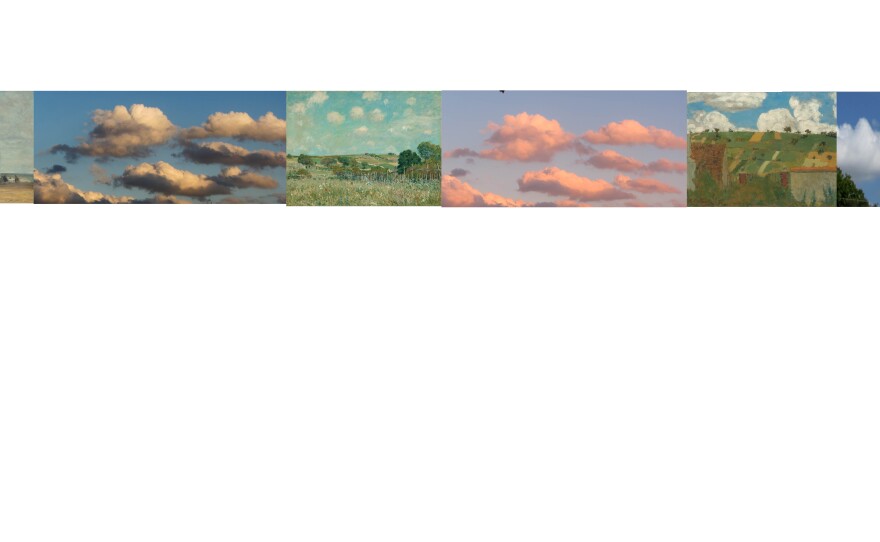It was Joni Mitchell who penned the lyric “it's cloud illusions I recall, I really don't know clouds at all.” I'm not sure why, but this song, "Both Sides Now," always comes into my mind when I turn my eyes toward the heavens to better see the clouds.
Whether the impressionist painters had a similar lyric come into their minds as they craned their necks to better see the skies is a silly and irrelevant question, for I would assume they were focused on seeing that exact moment when clouds, sky and light come together in an extraordinary way. Then, lightning fast, they would touch brush to paint to canvas, capturing that one inspired moment, then waiting for the next.
It was not just a changing aesthetic which moved artists out of their studios. According to the McNay Art Museum's director, Bill Chiego, technology was also at play.
"When you look at paintings of the early 19th Century, they always seem much darker than the impressionist pictures and it's largely because the impressionists changed their preparation of the canvas to a lighter color to begin with, and then used brighter colors. A lot of this had to do with technology. Suddenly by the mid-19th Century, paint in tubes was available, which also meant they could take a canvas and their tubes and paint out-of-doors easily."
Claude Monet was among the leading French impressionists, a generalized group of painters who preferred landscape over religious subject, working in the out-of-doors to working inside a studio.
Monet's philosophy was that "landscape is nothing but an impression - an instantaneous one." Monet would patiently watch the shifting sun and shadows, quickly brushing to the canvas the moment he wanted to describe. He was such a curiosity that the children would follow him about, carrying his canvases for him.
The writer Guy de Maupassant also followed Monet, sketching with words his description of the artist's gifts: “He would pick up with a few strokes of his brush the falling sun ray or the passing cloud, leaving aside the false and conventional.”
Intimate Impressionism, the show currently hanging at San Antonio's McNay Art Museum, displays only one canvas by Monet, but it does allow us to see the artist's way with a sky filled with clouds.
It was Eugène Boudin who showed Monet the way. When Boudin first came to know Monet, Monet's interest was in drawing caricatures. Boudin convinced Monet to come with him to the northern coast of France, a geography known as the channel coast. This was home to Boudin, perhaps the reason he was able to capture the shifting interplay of light, sky and clouds. Boudin earned the reputation as “king of the skies,” and there's ample evidence of his way with clouds, sky, and an horizon which almost always included the sea. Mary Morton, of the National Gallery, explains:
"I would say that's true, and it's the light that he knew and he grew up with it. So I think painting what you know, and what you have a real feel for, becomes part of the personal and real individual nature of artistic expression. But it's hard! Painting the channel coast is not an easy thing."
Composers, too, were fascinated by the challenge of capturing in sound their impressions of the world around them. Debussy captured the perfumes of the night. Falla wrote musical description of "Nights in the Gardens of Spain." In 1899, Debussy revealed his musical impression of clouds, saying of the opening of his set of Three Nocturnes, a movement titled Nuages (Clouds): 'Nuages' renders the immutable aspect of the sky and the slow, solemn motion of the clouds, fading away in grey tones lightly tinged with white.
Although Charles Tomlinson Griffes wrote his music from a place far removed from the channel coast, his richly textured impression of clouds, could serve as a soundtrack to not only the clouds within a Boudin landscape, but also the moments of clouds and light found in many of the works of Alfred Sisley. And how about my favorite clouds of all, those found in EdouardVuillard's Landscape of the Ile-de-France. Is that the painting best served by Alison Balsom's sultry reading of DjangoReinhardt's musical vision of clouds, his harmonically complex Nuages?
Intimate Impressionism continues to hang at the McNay through January 4th. Don't wait, see it now, allowing time to see it a second time. Meanwhile, don't miss my ongoing 4-part radio series, Intimate Impressionism on KPAC which continues Friday nights at 7 on KPAC-San Antonio through November 7th.











